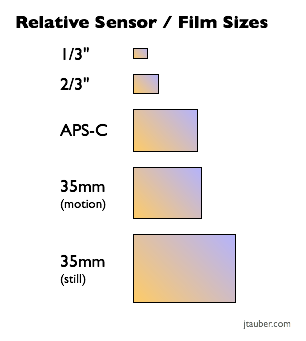Sensor Sizes
I mentioned before that my new HD camera has 1/3" sensors. That means that each of the three CCDs that detect light to be encoded on tape measures 4.8mm x 3.6mm (a diagonal of 6mm).
Now I realise none of these measures are equivalent to 1/3". I've read contradictory information about why a 4:3 ratio sensor with a diagonal of 6mm is called a 1/3" (although note that 4.8mm + 3.6mm is almost 1/3") so we'll just treat 1/3" as a name for 4.8mm x 3.6mm.
This is a fair bit smaller than 35mm film as you can see from this comparison chart I've drawn up (which includes both sensors and film for both still photography and motion pictures):

Why are there two pictures for 35mm? 35mm motion picture film frames travel vertically whereas 35mm still film frames travel horizontally. So the width you see of the 35mm motion picture frame is the height of the 35mm still frame (24mm). The aspect ratios are also different. Motion picture film is 4:3 whereas still is 3:2. Note however that, in the case of motion pictures, not all of this area is used as the sound may be recorded along one side (reducing the width to around 22mm) or the top and bottom of the frame masked to change the aspect ratio to the more common 1.85:1 used in movies.
APS-C is the size used by some DSLR still cameras such as my Canon 10D. You may have heard me mention how much I'd like a 5D which has a full-size frame, by which I mean the 35mm (still) sensor at the bottom.
Professional video cameras typically use 2/3" sensors. The use of a 1/3" sensor in the "prosumer" HD cameras like my JVC are one of the key things that distinguishes them from the truly professional cameras. Note, however, that an HD camera with 1/3" sensors is capable of producing images of a higher resolution than a 2/3" standard definition camera.
Lucas used cameras with 2/3" sensors in Episode II and III. There are high-end video cameras with full-frame (i.e. 35mm) sensors in the works.
The size of the sensor impacts things like cost, light sensitivity and the field of view relative to focal length (I'll talk about that last one soon). Ironically, a smaller sensor (like a 1/3" versus 2/3" in video or an APS-C versus 35mm in DSLRs), although cheaper to manufacture and considered less professional, actually requires a sharper lens to resolve the same resolution. A small sensor is packing more lines per mm so a lens has to be capable of resolving that.
The original post was in the categories: filmmaking photography but I'm still in the process of migrating categories over.
The original post had 2 comments I'm in the process of migrating over.